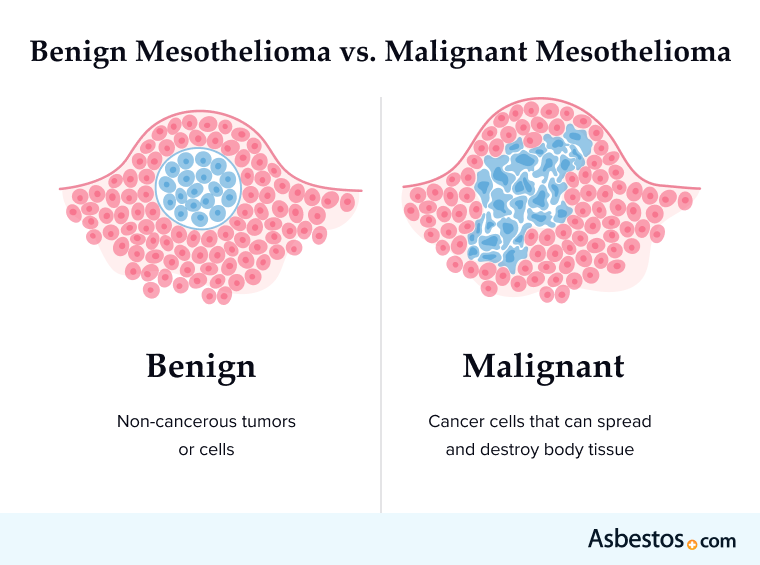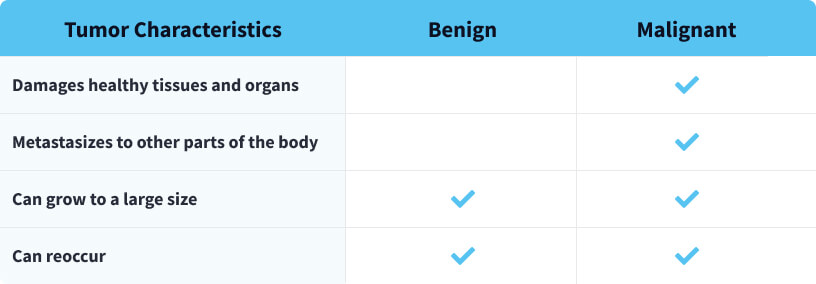Get in Touch
Have questions? Call or chat with our Patient Advocates for answers.
Benign mesothelioma is a rare, noncancerous growth in the mesothelium that has not spread, or metastasized, to other parts of the body. There are several types of benign mesothelioma. These tumors can be removed with surgery and are not considered life-threatening.

Written by Karen Selby, RN | Medically Reviewed By Dr. Andrea Wolf | Edited By Walter Pacheco | Last Update: June 27, 2024
Benign mesothelioma is a noncancerous growth in the lung lining or abdominal lining. Benign tumors do not invade other tissues or spread to other areas of the body like malignant tumors. Benign mesothelioma tumors grow at a slower rate. They tend to form a singular mass rather than the many tumor nodules seen in malignant cases.
Researchers have identified several types of benign mesothelioma, and each is rarer than malignant mesothelioma. For example, benign multicystic peritoneal mesothelioma has less than 200 reported cases. Another benign type, called well-differentiated papillary mesothelioma tumor, has 180 documented cases.

Doctors aren’t sure what causes benign mesothelioma. The history of asbestos exposure in people with benign mesothelioma is not well-documented. At least 80% to 90% of people with malignant mesothelioma have a history of asbestos exposure.
People with benign and malignant mesothelioma tumors share certain symptoms such as abdominal pain and shortness of breath. Patients with malignant mesothelioma are more likely to experience weight loss, while those with benign tumors tend to experience weight gain.
Effective treatment and full recovery are possible for most people with benign mesothelioma. However, if tumors return they may become malignant. For this reason, doctors must continue to watch for new tumors. Accurate diagnosis and treatment planning are crucial for optimal outcomes in cases of benign mesothelioma.
There are several benign mesothelioma types defined by the cell characteristics of the tumors. Unlike malignant versions, benign tumors respond well to treatment, which is good news for patients.
Benign mesotheliomas can occur in the lining of the lung, heart, abdomen and testes. The most common type is benign multicystic mesothelioma.
WDPMT has shown the greatest chance of becoming malignant of these benign tumor types. In general, all patients with benign types are monitored after treatment to check for signs of the tumors returning.

Learn about your diagnosis, top doctors and how to pay for treatment.
Get Your Free GuideIn general, symptoms of benign mesothelioma are similar to the symptoms of malignant mesothelioma. Benign tumors can grow large enough to negatively impact nearby tissues and organs. Symptoms vary depending on the affected organ, and may affect tissues in the chest, abdomen or pelvis.
Benign pleural tumors may also cause low blood sugar and, rarely, seizures or coma. People with malignant pleural mesothelioma experience these same symptoms. They also show additional symptoms such as fever, night sweats and weight loss.
When benign mesothelioma forms in the abdomen, the condition may cause abdominal swelling or distention and tenderness. Palpable masses within the abdomen or pelvis may be present.
Benign mesothelioma symptoms may also be more ambiguous in some cases. A 2021 report documented a 25-year-old woman with unusual symptoms. They included constipation, urinary urgency and irregular menstruation. This case study highlighted the challenges of diagnosing certain types of benign mesothelioma.
The diagnostic process for benign mesothelioma includes a physical exam, medical history, blood tests, imaging scans and biopsy. The most important tool is a biopsy because it shows whether a tumor’s cells are benign or malignant.
A biopsy also shows the specific cell type that makes up the benign tumor. This information is helpful because certain types are at low risk of becoming malignant mesothelioma.
The prognosis for benign mesothelioma is favorable, especially when the tumor is completely surgically removed. Recurrences are common but can be managed with another surgery. In some cases, a more aggressive surgical approach is necessary. Surgery may be combined with heated intraperitoneal chemotherapy for abdominal cases.
Doctors have identified a few risk factors for recurrence. Recurrence has been more common among cases that develop in the abdomen. Incomplete surgical removal can lead to local recurrence.
Life expectancy for patients is generally unaffected by benign mesothelioma because the disease responds well to surgical management. Most people can live a full, unrestricted life following surgical treatment.
The only words of advice I have to anyone fighting cancer of any kind is to keep hope, stay strong and positive and express your feelings. Do not be afraid to ask questions, and call your doctor’s medical assistant every day if you have to. You have to learn to laugh, and keep your humor.
Unfortunately, a small chance of malignant transformation is possible. People with the condition should be aware of the possibility of recurrence and the rare chance of progression to malignancy. A biopsy can identify if a benign mesothelioma tumor has turned malignant.
Factors that can influence prognosis include the patient’s age, gender, malignant transformation and family history of developing these tumors. Other factors include a history of abdominal surgeries, alcohol use and smoking.
Benign mesothelioma is primarily treated with surgery. Tumors in the abdominal lining may also be treated with heated chemotherapy during surgery. This helps reduce the rate of recurrence. Postoperative systemic chemotherapy is generally not recommended.
80%
The percent of multicystic peritoneal patients remaining disease free 10 years after surgery with heated chemotherapy.
Recurrence of benign mesothelioma is less common in pleural cases than in peritoneal cases. About 3% of pleural cases recur, while about half recur in peritoneal cases without heated chemotherapy.
It’s important to understand the potential risks associated with surgery. For example, fluid buildup after surgery may require the installation of a chest drain to prevent effusion.
A surgical procedure called a thoracotomy treats benign pleural mesothelioma. The details of surgery depend on the size and location of the tumor. A thoracotomy may involve the removal of a segment of the lung, a lobe or even the entire lung. However, removal of the entire lung is infrequent in benign cases.
Although benign pleural mesothelioma is controllable, complications may develop following surgery. The most common side effect of surgery is pleural effusion, a fluid buildup in the pleural spaces that puts pressure on the lungs and heart. Patients are usually fitted with a chest drain for the first few days after surgery to remove excess fluid and prevent effusion.
Doctors use the same treatments for both benign and malignant peritoneal mesothelioma. Benign cases treated with this aggressive approach have a high rate of long-term survival.
Surgeons use cytoreductive surgery to remove growths from the abdominal cavity. Heated chemotherapy follows the surgery. This combined procedure has reduced the rate of recurrence to about 20%.
In the past, laparotomy or laparoscopy removed the growth. Unfortunately, the tumors often returned, especially in women. Women showed a recurrence rate of 40% to 50%, while men had a 33% recurrence rate after surgery.
A key difference between benign and malignant tumors is that benign tumors do not invade nearby tissues. They generally do not spread to other parts of the body. For this reason, benign mesothelioma is much less dangerous than malignant mesothelioma. However, benign tumors can still cause complications and discomfort.
Doctors can determine if mesothelioma is benign or malignant by looking at tumor cells under a microscope. A biopsy is the only test that differentiates benign mesothelioma from malignant mesothelioma.

A solid, single tumor mass in the lining of the lungs (mesothelium) may show benign mesothelioma. Many small tumors on the lung lining are more likely malignant. But benign multicystic peritoneal mesothelioma causes several growths in the peritoneum (abdominal cavity).
Malignant mesotheliomas tend to surface 20 to 60 years after asbestos exposure. Benign mesothelioma can occur at any age.
Recommended ReadingThank you for your feedback. Would you like to speak with a Patient Advocate?
Your web browser is no longer supported by Microsoft. Update your browser for more security, speed and compatibility.
If you are looking for mesothelioma support, please contact our Patient Advocates at (855) 404-4592
The Mesothelioma Center at Asbestos.com has provided patients and their loved ones the most updated and reliable information on mesothelioma and asbestos exposure since 2006.
Our team of Patient Advocates includes a medical doctor, a registered nurse, health services administrators, veterans, VA-accredited Claims Agents, an oncology patient navigator and hospice care expert. Their combined expertise means we help any mesothelioma patient or loved one through every step of their cancer journey.
More than 30 contributors, including mesothelioma doctors, survivors, health care professionals and other experts, have peer-reviewed our website and written unique research-driven articles to ensure you get the highest-quality medical and health information.
My family has only the highest compliment for the assistance and support that we received from The Mesothelioma Center. This is a staff of compassionate and knowledgeable individuals who respect what your family is experiencing and who go the extra mile to make an unfortunate diagnosis less stressful. Information and assistance were provided by The Mesothelioma Center at no cost to our family.LashawnMesothelioma patient’s daughter


Selby, K. (2024, June 27). Benign Mesothelioma. Asbestos.com. Retrieved July 26, 2024, from https://www.asbestos.com/mesothelioma/benign/
Selby, Karen. "Benign Mesothelioma." Asbestos.com, 27 Jun 2024, https://www.asbestos.com/mesothelioma/benign/.
Selby, Karen. "Benign Mesothelioma." Asbestos.com. Last modified June 27, 2024. https://www.asbestos.com/mesothelioma/benign/.
The Mesothelioma Center at Asbestos.com has provided patients and their loved ones the most updated and reliable information on mesothelioma and asbestos exposure since 2006.
Our team of Patient Advocates includes a medical doctor, a registered nurse, health services administrators, veterans, VA-accredited Claims Agents, an oncology patient navigator and hospice care expert. Their combined expertise means we help any mesothelioma patient or loved one through every step of their cancer journey.
More than 30 contributors, including mesothelioma doctors, survivors, health care professionals and other experts, have peer-reviewed our website and written unique research-driven articles to ensure you get the highest-quality medical and health information.
My family has only the highest compliment for the assistance and support that we received from The Mesothelioma Center. This is a staff of compassionate and knowledgeable individuals who respect what your family is experiencing and who go the extra mile to make an unfortunate diagnosis less stressful. Information and assistance were provided by The Mesothelioma Center at no cost to our family.LashawnMesothelioma patient’s daughter


Selby, K. (2024, June 27). Benign Mesothelioma. Asbestos.com. Retrieved July 26, 2024, from https://www.asbestos.com/mesothelioma/benign/
Selby, Karen. "Benign Mesothelioma." Asbestos.com, 27 Jun 2024, https://www.asbestos.com/mesothelioma/benign/.
Selby, Karen. "Benign Mesothelioma." Asbestos.com. Last modified June 27, 2024. https://www.asbestos.com/mesothelioma/benign/.
The Mesothelioma Center at Asbestos.com has provided patients and their loved ones the most updated and reliable information on mesothelioma and asbestos exposure since 2006.
Our team of Patient Advocates includes a medical doctor, a registered nurse, health services administrators, veterans, VA-accredited Claims Agents, an oncology patient navigator and hospice care expert. Their combined expertise means we help any mesothelioma patient or loved one through every step of their cancer journey.
More than 30 contributors, including mesothelioma doctors, survivors, health care professionals and other experts, have peer-reviewed our website and written unique research-driven articles to ensure you get the highest-quality medical and health information.
My family has only the highest compliment for the assistance and support that we received from The Mesothelioma Center. This is a staff of compassionate and knowledgeable individuals who respect what your family is experiencing and who go the extra mile to make an unfortunate diagnosis less stressful. Information and assistance were provided by The Mesothelioma Center at no cost to our family.LashawnMesothelioma patient’s daughter


Selby, K. (2024, June 27). Benign Mesothelioma. Asbestos.com. Retrieved July 26, 2024, from https://www.asbestos.com/mesothelioma/benign/
Selby, Karen. "Benign Mesothelioma." Asbestos.com, 27 Jun 2024, https://www.asbestos.com/mesothelioma/benign/.
Selby, Karen. "Benign Mesothelioma." Asbestos.com. Last modified June 27, 2024. https://www.asbestos.com/mesothelioma/benign/.
The Mesothelioma Center at Asbestos.com has provided patients and their loved ones the most updated and reliable information on mesothelioma and asbestos exposure since 2006.
Our team of Patient Advocates includes a medical doctor, a registered nurse, health services administrators, veterans, VA-accredited Claims Agents, an oncology patient navigator and hospice care expert. Their combined expertise means we help any mesothelioma patient or loved one through every step of their cancer journey.
More than 30 contributors, including mesothelioma doctors, survivors, health care professionals and other experts, have peer-reviewed our website and written unique research-driven articles to ensure you get the highest-quality medical and health information.
My family has only the highest compliment for the assistance and support that we received from The Mesothelioma Center. This is a staff of compassionate and knowledgeable individuals who respect what your family is experiencing and who go the extra mile to make an unfortunate diagnosis less stressful. Information and assistance were provided by The Mesothelioma Center at no cost to our family.LashawnMesothelioma patient’s daughter


Selby, K. (2024, June 27). Benign Mesothelioma. Asbestos.com. Retrieved July 26, 2024, from https://www.asbestos.com/mesothelioma/benign/
Selby, Karen. "Benign Mesothelioma." Asbestos.com, 27 Jun 2024, https://www.asbestos.com/mesothelioma/benign/.
Selby, Karen. "Benign Mesothelioma." Asbestos.com. Last modified June 27, 2024. https://www.asbestos.com/mesothelioma/benign/.
The Mesothelioma Center at Asbestos.com has provided patients and their loved ones the most updated and reliable information on mesothelioma and asbestos exposure since 2006.
Our team of Patient Advocates includes a medical doctor, a registered nurse, health services administrators, veterans, VA-accredited Claims Agents, an oncology patient navigator and hospice care expert. Their combined expertise means we help any mesothelioma patient or loved one through every step of their cancer journey.
More than 30 contributors, including mesothelioma doctors, survivors, health care professionals and other experts, have peer-reviewed our website and written unique research-driven articles to ensure you get the highest-quality medical and health information.
My family has only the highest compliment for the assistance and support that we received from The Mesothelioma Center. This is a staff of compassionate and knowledgeable individuals who respect what your family is experiencing and who go the extra mile to make an unfortunate diagnosis less stressful. Information and assistance were provided by The Mesothelioma Center at no cost to our family.LashawnMesothelioma patient’s daughter


Selby, K. (2024, June 27). Benign Mesothelioma. Asbestos.com. Retrieved July 26, 2024, from https://www.asbestos.com/mesothelioma/benign/
Selby, Karen. "Benign Mesothelioma." Asbestos.com, 27 Jun 2024, https://www.asbestos.com/mesothelioma/benign/.
Selby, Karen. "Benign Mesothelioma." Asbestos.com. Last modified June 27, 2024. https://www.asbestos.com/mesothelioma/benign/.
The Mesothelioma Center at Asbestos.com has provided patients and their loved ones the most updated and reliable information on mesothelioma and asbestos exposure since 2006.
Our team of Patient Advocates includes a medical doctor, a registered nurse, health services administrators, veterans, VA-accredited Claims Agents, an oncology patient navigator and hospice care expert. Their combined expertise means we help any mesothelioma patient or loved one through every step of their cancer journey.
More than 30 contributors, including mesothelioma doctors, survivors, health care professionals and other experts, have peer-reviewed our website and written unique research-driven articles to ensure you get the highest-quality medical and health information.
My family has only the highest compliment for the assistance and support that we received from The Mesothelioma Center. This is a staff of compassionate and knowledgeable individuals who respect what your family is experiencing and who go the extra mile to make an unfortunate diagnosis less stressful. Information and assistance were provided by The Mesothelioma Center at no cost to our family.LashawnMesothelioma patient’s daughter


Selby, K. (2024, June 27). Benign Mesothelioma. Asbestos.com. Retrieved July 26, 2024, from https://www.asbestos.com/mesothelioma/benign/
Selby, Karen. "Benign Mesothelioma." Asbestos.com, 27 Jun 2024, https://www.asbestos.com/mesothelioma/benign/.
Selby, Karen. "Benign Mesothelioma." Asbestos.com. Last modified June 27, 2024. https://www.asbestos.com/mesothelioma/benign/.
The Mesothelioma Center at Asbestos.com has provided patients and their loved ones the most updated and reliable information on mesothelioma and asbestos exposure since 2006.
Our team of Patient Advocates includes a medical doctor, a registered nurse, health services administrators, veterans, VA-accredited Claims Agents, an oncology patient navigator and hospice care expert. Their combined expertise means we help any mesothelioma patient or loved one through every step of their cancer journey.
More than 30 contributors, including mesothelioma doctors, survivors, health care professionals and other experts, have peer-reviewed our website and written unique research-driven articles to ensure you get the highest-quality medical and health information.
My family has only the highest compliment for the assistance and support that we received from The Mesothelioma Center. This is a staff of compassionate and knowledgeable individuals who respect what your family is experiencing and who go the extra mile to make an unfortunate diagnosis less stressful. Information and assistance were provided by The Mesothelioma Center at no cost to our family.LashawnMesothelioma patient’s daughter


Selby, K. (2024, June 27). Benign Mesothelioma. Asbestos.com. Retrieved July 26, 2024, from https://www.asbestos.com/mesothelioma/benign/
Selby, Karen. "Benign Mesothelioma." Asbestos.com, 27 Jun 2024, https://www.asbestos.com/mesothelioma/benign/.
Selby, Karen. "Benign Mesothelioma." Asbestos.com. Last modified June 27, 2024. https://www.asbestos.com/mesothelioma/benign/.
The Mesothelioma Center at Asbestos.com has provided patients and their loved ones the most updated and reliable information on mesothelioma and asbestos exposure since 2006.
Our team of Patient Advocates includes a medical doctor, a registered nurse, health services administrators, veterans, VA-accredited Claims Agents, an oncology patient navigator and hospice care expert. Their combined expertise means we help any mesothelioma patient or loved one through every step of their cancer journey.
More than 30 contributors, including mesothelioma doctors, survivors, health care professionals and other experts, have peer-reviewed our website and written unique research-driven articles to ensure you get the highest-quality medical and health information.
My family has only the highest compliment for the assistance and support that we received from The Mesothelioma Center. This is a staff of compassionate and knowledgeable individuals who respect what your family is experiencing and who go the extra mile to make an unfortunate diagnosis less stressful. Information and assistance were provided by The Mesothelioma Center at no cost to our family.LashawnMesothelioma patient’s daughter


Selby, K. (2024, June 27). Benign Mesothelioma. Asbestos.com. Retrieved July 26, 2024, from https://www.asbestos.com/mesothelioma/benign/
Selby, Karen. "Benign Mesothelioma." Asbestos.com, 27 Jun 2024, https://www.asbestos.com/mesothelioma/benign/.
Selby, Karen. "Benign Mesothelioma." Asbestos.com. Last modified June 27, 2024. https://www.asbestos.com/mesothelioma/benign/.
The Mesothelioma Center at Asbestos.com has provided patients and their loved ones the most updated and reliable information on mesothelioma and asbestos exposure since 2006.
Our team of Patient Advocates includes a medical doctor, a registered nurse, health services administrators, veterans, VA-accredited Claims Agents, an oncology patient navigator and hospice care expert. Their combined expertise means we help any mesothelioma patient or loved one through every step of their cancer journey.
More than 30 contributors, including mesothelioma doctors, survivors, health care professionals and other experts, have peer-reviewed our website and written unique research-driven articles to ensure you get the highest-quality medical and health information.
My family has only the highest compliment for the assistance and support that we received from The Mesothelioma Center. This is a staff of compassionate and knowledgeable individuals who respect what your family is experiencing and who go the extra mile to make an unfortunate diagnosis less stressful. Information and assistance were provided by The Mesothelioma Center at no cost to our family.LashawnMesothelioma patient’s daughter


Selby, K. (2024, June 27). Benign Mesothelioma. Asbestos.com. Retrieved July 26, 2024, from https://www.asbestos.com/mesothelioma/benign/
Selby, Karen. "Benign Mesothelioma." Asbestos.com, 27 Jun 2024, https://www.asbestos.com/mesothelioma/benign/.
Selby, Karen. "Benign Mesothelioma." Asbestos.com. Last modified June 27, 2024. https://www.asbestos.com/mesothelioma/benign/.
The Mesothelioma Center at Asbestos.com has provided patients and their loved ones the most updated and reliable information on mesothelioma and asbestos exposure since 2006.
Our team of Patient Advocates includes a medical doctor, a registered nurse, health services administrators, veterans, VA-accredited Claims Agents, an oncology patient navigator and hospice care expert. Their combined expertise means we help any mesothelioma patient or loved one through every step of their cancer journey.
More than 30 contributors, including mesothelioma doctors, survivors, health care professionals and other experts, have peer-reviewed our website and written unique research-driven articles to ensure you get the highest-quality medical and health information.
My family has only the highest compliment for the assistance and support that we received from The Mesothelioma Center. This is a staff of compassionate and knowledgeable individuals who respect what your family is experiencing and who go the extra mile to make an unfortunate diagnosis less stressful. Information and assistance were provided by The Mesothelioma Center at no cost to our family.LashawnMesothelioma patient’s daughter


Selby, K. (2024, June 27). Benign Mesothelioma. Asbestos.com. Retrieved July 26, 2024, from https://www.asbestos.com/mesothelioma/benign/
Selby, Karen. "Benign Mesothelioma." Asbestos.com, 27 Jun 2024, https://www.asbestos.com/mesothelioma/benign/.
Selby, Karen. "Benign Mesothelioma." Asbestos.com. Last modified June 27, 2024. https://www.asbestos.com/mesothelioma/benign/.
A medical doctor who specializes in mesothelioma or cancer treatment reviewed the content on this page to ensure it meets current medical standards and accuracy.
Please read our editorial guidelines to learn more about our content creation and review process.
Dr. Andrea Wolf is the Director of the New York Mesothelioma Program at Mount Sinai in New York City. She focuses on multidisciplinary treatment, clinical research, community outreach and education.
A medical doctor who specializes in mesothelioma or cancer treatment reviewed the content on this page to ensure it meets current medical standards and accuracy.
Please read our editorial guidelines to learn more about our content creation and review process.
Dr. Andrea Wolf is the Director of the New York Mesothelioma Program at Mount Sinai in New York City. She focuses on multidisciplinary treatment, clinical research, community outreach and education.
Mesothelioma Center - Vital Services for Cancer Patients & Families doesn’t believe in selling customer information. However, as required by the new California Consumer Privacy Act (CCPA), you may record your preference to view or remove your personal information by completing the form below.
